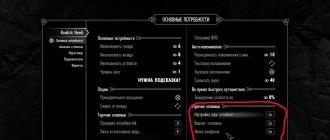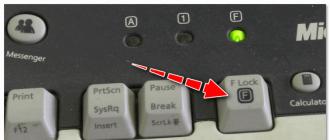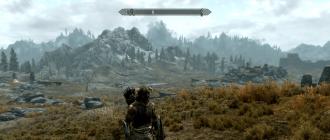Read how to avoid file corruption or fix an already corrupted one. What are the causes of file corruption and how to protect them from it. File corruption is relatively rare on today's well-protected computers. But sometimes it happens and a difficult moment comes for you. Can a corrupted file be saved?
Let's take a look at the common causes of file corruption, how you can prevent it, and what to do if it has already happened.
Content:
What causes file corruption?

More often than not, files can become corrupted when they are saved to disk. This can happen in different ways. The most common case is when an application encounters an error while saving or creating a file. When saving a document, an office application may encounter an error at the wrong time. At the time of file compression, a problem may arise when creating an archive. When creating a backup, your backup tool may fail. The browser (or any other download application) may also have problems writing the downloaded file to disk.
More often than not, these apps will notice the error and report it, giving you a chance to try again. But sometimes, unfortunately, you are not aware of the error until you try to open the file later.
There are, of course, other reasons why files can get corrupted.
When you turn off your computer, you are prompted to properly close all files that were open (or at least given a chance to do so). When this does not happen - for example, in the event of a power failure or failure during the shutdown of the computer - the program does not have the opportunity to close all files correctly. This can damage any files that are currently open, including not only your documents, but even operating system files.
Hard drive problems can also lead to file corruption. The presence of bad physical sectors on the disk, mechanical damage, or signs of resource depletion can cause file corruption. Sometimes even small errors, such as files with a common cluster or lost clusters, can be the culprit in file corruption.
And, of course, malware and viruses can corrupt files. Often the fact of computer infection is detected when most of the information is corrupted or destroyed. Although this case is more deliberate than accidental.

First of all, the first thing you can do to protect your files is to back up all your data permanently. But note that cloud storage and other forms of file sync may not be enough to do the job. If you have a corrupted file on your local drive that is then synced to your cloud storage, then it will be replaced with a bad file and you won't have a good copy. If you rely on cloud storage, then at least make sure you have the ability to find previous versions of files (like Dropbox, for example).
It's always better to use the right backup solutions like File history(on Windows), Time Machine (on macOS), or Backblaze, which allow you to restore multiple previous versions of files.
Then be sure to make sure your computer is protected from viruses and malware. This includes not only a good antivirus application, but common sense when viewing suspicious information and downloading.
And finally, you should consider purchasing an uninterruptible power supply (UPS) to protect your computer from power outages or power failures. The UPS acts as a backup battery that provides power to your computer in the event of a power failure. They tend to take up little space and give you anywhere from a few minutes to an hour or more, depending on battery power. This is quite enough to save information and properly shut down the computer. Having a good UPS will help protect your files from crash damage and prevent the hardware problems that crash can cause.
What can you do when a file is damaged?

If you have a corrupted file, it's best to replace that file with a healthy one. Download it again if you downloaded it before, or download it from a saved backup.
In case of corrupted system files (from an unexpected power outage, incorrect update or malware), you can always try the application built into the standard set of Windows - System File Checker. It scans your system for corrupted system files and then replaces them with the originals.
Before you do that, it's best to try and fix the cause of the problem. In the case of viruses, you must first make sure that you have removed all malware from your computer. And if you are sure that the problem with the update was caused by viruses, then you will be able to complete the installation of the update correctly.
If your corrupted file is a document you created, then unfortunately your options are limited. Some applications (such as those included with Microsoft Office) automatically save multiple versions of your document, allowing you to open a previous version if the current version is corrupted.
If you are unable to open a previous version, you can restore the file, or at least recover text from it. The standard Microsoft Office applications offer built-in tools for recovering lost and damaged documents, as do some other programs. Even if you can't recover all of the text from a document, but only part of it, you'll still save a lot of time when recreating the entire document.
There are also several applications that claim to be able to repair various types of corrupted files. Some of them are free and some are paid. But truth be told, not all of them work well. And some of the programs we tested were overly bloated with companion apps, or worse, infected with viruses. Given this, we recommend simply not using them.
If you need to recover damaged JPEG, TIFF, PNG or BMP files, use the program
This article allows you to take several paths through which you can recover corrupted files on your system, whether it be Windows, Mac, or Linux. So read on, there is something to see. Word an error occurred while trying to open the file You are familiar, aren't you? This can be a big problem if the file is corrupted, and it is very important. When you try to open a certain file, it shows the message “cannot open file” or “data file is not available”, you should understand that the file is corrupted. The file will also be corrupted if it is available, but the content is shown as some characters » / » garbage » instead of numbers and alphabet.
So what will you do next? Here are various ways you can try to restore your important files to your system.
Word on Windows
Here are some methods to recover word files. If you cannot recover word files, then you can at least try to recover data from those files.
Method 1:
The easiest way to recover files would be the File option in the Word document toolbar by clicking Open.
A dialog box will appear with all existing doc/docx files.
Select the file you want to restore and click on the little arrow on the ‘open’ side.
In the drop-down window that appears, select Open and the Repair option.
Method 2:
The second way is to change the file extension, from the current standard .doc extension. This will be a new file that is not corrupted but will contain the same document information.
Way 3:
Another way to repair corrupted files is to link the file to a new uncorrupted file. To do this, open Word, and on the toolbar, select the File menu. Select New Option, and in the dialog box, select the Blank Document type.
You can enter some initial data into this file and then save it.
Highlight the text you wrote and copy it.
From the File menu, select the New option, and then select Blank Document.
In this document, go to the Edit menu and choose Paste Special. In the dialog that opens, select the Formatted Text (RTF) option, check the Insert Link option, and click OK.
Go to the Edit menu, click on Links.
In the dialog box that appears, select the Filename of the document that is linked, and then select the Change Source option.
In the new dialog box, select the corrupted file that you cannot open and click on the Open option.
Now again go to the Edit menu and click on the Links option.
In the dialog box that appears, click on the Unlink option. You will be prompted to break the selected links, click on Yes. The corrupted file's data will be transferred to this new document. You can save this new document and format it accordingly.
JPEG/JPG files on Windows
This file type contains a photo or picture. When a JPEG file does not open in any of the standard programs such as P aints, Windows Fax Viewer Photo Gallery, and so on, it can be corrupted. And if the file is corrupted, you won't be able to view the images. You should first try getting the file by renaming and saving its .jpg file extension. If that doesn't work, then the next step would be to get the help of some JPEG image recovery application. JPEG Recovery and D octor image Here are a few applications that can be used to repair damaged JPEG files.
Excel files in Windows
Follow the below methods to recover excel files.
Method 1:
Open Excel file.
From the toolbar menu, navigate to File and click on Open. A new Open dialog box will appear.
Click on the excel file you want to open. There will be a small arrow in the direction of the ‘Open’ button.
Click on it, a drop-down menu will appear. Select the "Open and Repair" option.
A window will appear asking if you want to recover or extract data from the file. Select the Restore option, and check if that suits your purposes. Alternatively, you can extract the data from the file and save it in a new file.
Method 2:
Method 3:
If you can open the corrupted file, then go to the File menu and select the Save As option.
Select the books that are damaged and select an extension such as .slk. You can then close the book.
Now again click on the File option on the toolbar, click on the Open button.
This time select the file type SYLK , and open the file.
Now go to File and select the Save As option. Now you can save the file with a new name and choose the .xls/xlsx extension. Your new file will have the same data as the previous one.
Method 4:
If you are unable to recover the file using the above methods, then this method may be useful. Open an Excel spreadsheet and click on the File button and then Open.
Navigate to the file you want to restore and click Cancel.
Now open a New Excel Spreadsheet, and in cell A1, enter =filename.xls!A1. You will be able to see all the data in the corrupted file in this cell. You can increase the width of the cell so that the entire content of the file is clearly visible.
Media files in Windows
There are many types of media files that we usually store on our hard drive, such as AVI, DAT, MP4, .mpeg3, etc. Like other documents, images, and program files, these files can become corrupted. The typical way to recover media files is to use certain software. There are many applications that can repair corrupted files of all types of media files. Working with these applications is very simple. You just need to open the program, press the browse button, select the damaged file to be repaired, and select the repair option.
The best way to recover your files is to let Windows run a self-test. Go to Start in the Search window, type cmd. Right click on cmd.exe and select Run as administrator. Now, type chkdsk x: /r at the command prompt, replacing ‘x’, which is the first letter of the drive where the corrupted file is located. This drive will be checked for errors and corrupted files will be repaired.
Working in safe mode
If your file is corrupted and you cannot open it, you can try to open it in Safe Mode. You can type winword.exe /safe in Start → Search.
Note: Similar modules can be used in other Office applications.
OpenOffice files on Windows
On most computer systems, OpenOffice is installed in place of the stock Microsoft Office. In any case of damage to a file in this format, you can restore it with the following method. However, it must be remembered that if a file is corrupted and has not been saved again, it cannot be restored.
All files that have been developed for OpenOffice formats are saved in a separate folder. To find out the exact Backup Folder, go to Tools ➛ Option ➛ OpenOffice.org. Check the backup and browse this folder to get the desired file. You can restore the previous version and thus restore the file.
Corrupted files in Linux
In case you are running on a Linux platform, here are a few ways you can follow to recover corrupted files. On Linux, the fsck system utility is the most useful for checking the integrity of files. This option checks the file system, and can repair the file if necessary when the following syntax is used.
fsck Fs-name-here, where Fs-name-here can be a device name, a mount point, an ext2 label, or a UUID specifier.
fsck /dev/xyz
fsck /home
fsck.ext3 /dev/hdc1
fsck.ext2 /dev/flash/devices/name
You can only restore if the file is not working. So, first take the system down one level and turn it off.
# init 1
# disable /home
# fsck.ext3 /dev/hda3
When the file system asks for a fix, press the y key.
# fsck-y /dev/hda3
After the repair is done, remount the filesystem.
# mount /home
# init 3
Corrupted files in Mac
The Mac operating system can recover most damaged or accidentally deleted files. For convenience, recovery is mentioned in the document. You can restore other Office files in a similar way.
Method 1:
You can change the file to another format, i.e., Rich Text Format (RTF), to recover the file.
Go to File and click on Save As.
Select Text In Rtf Format from the drop-down box and save the file.
Now, open the file in Word and save it again in its original format. If the problem is not too complex, this method will fix it.
Method 2:
In case the file cannot be opened, then you must paste it into a new document in order to restore its contents. Create a new document and go to Paste. Now, select the corrupted file, and click OK. This should work.
Method 3:
In case you cannot open files in this format yet, you can use the following method to do so. Open a blank document in word and type any word e.g. Type Test.
Now, press Ctrl+C or go to Edit and click on Copy to copy this word.
Go to the File menu and open New Document.
On the Edit menu, click on Paste Special, and then select the Paste Link option.
In » How to » select Formatted Text (RTF), and then click OK.
Now, in the Edit menu, click on Links and select Change Source.
From the Open menu, select the corrupted file and open it. Once the document is open, save it with a new name.
Now go to Links in the Edit menu and click on Break Links. Click the Yes button to break the link to make changes to the file.
If you still cannot repair the corrupted file, then you must have the necessary software and follow the steps that lead to file repair and data recovery.
When it comes to saving important files, it's always a good idea to keep a backup on a storage device. This will allow you to keep a copy of the original file. In addition, there are a number of recovery software available for download on the Internet. If these applications are not free, you always have the option of downloading the free version temporarily, just to repair a corrupted file.
Excel spreadsheet files may be corrupted. This can happen for completely different reasons: a sharp power outage during operation, incorrect saving of a document, computer viruses, etc. Of course, it is very unpleasant to lose information recorded in Excel books. Fortunately, there are effective options for its restoration. Let's find out exactly how you can recover corrupted files.
There are several ways to recover a damaged Excel workbook (file). The choice of a particular method depends on the level of data loss.
Method 1: copy sheets
If the Excel workbook is damaged, but still opens, then the fastest and most convenient way to recover is the one described below.


Thus, a new book with an intact structure has been created, which will contain data from the problem file.
Method 2: reformatting
This method is also suitable only if the damaged book is opened.
- Open the workbook in Excel. Go to tab "File".
- In the left part of the window that opens, click on the item "Save as…".
- The save window opens. Choose any directory where the book will be saved. However, you can leave the place that the program indicates by default. The main thing in this step is that in the parameter "File type" you need to select an item "Webpage". Be sure to check that the save switch is in position "Whole Book", but not "Highlighted: Leaf". After the choice is made, click on the button "Save".
- Close the Excel program.
- Find the saved file in the format html in the directory where we saved it before. Right-click on it and select from the context menu "To open with". If there is an item in the additional menu list "Microsoft Excel", then we go over it.

Otherwise, click on the item "Select program...".
- The program selection window opens. Again, if in the list of programs you find "Microsoft Excel" select this item and click on the button OK.

Otherwise, click on the button "Overview…".
- An Explorer window opens in the directory of installed programs. You should go through the following address pattern:
C:\Program Files\Microsoft Office\Office#
In this template, instead of the symbol «№» you need to substitute the number of your Microsoft Office package.
In the window that opens, select the Excel file. Click on the button "Open".
- Returning to the window for choosing a program to open a document, select the position "Microsoft Excel" and click on the button OK.
- After the document is open, again go to the tab "File". Choose an item "Save as…".
- In the window that opens, set the directory where the updated book will be stored. In field "File type" install one of the Excel formats, depending on which extension the corrupted source has:
- Excel workbook (xlsx);
- Excel 97-2003 book (xls);
- Macro-enabled Excel workbook, etc.









Thus, we reformat the damaged file through the format html and save the information in a new book.
Using the same algorithm, it is possible to use not only html, but also xml and SYLK.
Attention! This method is not always able to save all data without loss. This is especially true for files with complex formulas and tables.
Method 3: Recovering a non-opening book
If you cannot open a book in the standard way, then there is a separate option to restore such a file.


After that, the data will be opened in a new file, in which the word “[restored]” will be added to the original name in the name.
Method 4: recovery in especially difficult cases
In addition, there are cases when none of the above methods helped to restore the file. This means that the structure of the book is severely damaged or something is preventing restoration. You can try to restore by performing additional steps. If the previous step does not help, then proceed to the next:
- Completely exit Excel and reload the program;
- Restart your computer;
- Delete the contents of the Temp folder, which is located in the "Windows" directory on the system drive, then restart the PC;
- Check your computer for viruses and, if found, eliminate them;
- Copy the damaged file to another directory, and from there try to restore using one of the methods described above;
- Try opening the damaged workbook in a newer version of Excel if you don't have the latest version installed. New versions of the program have more options for repairing damage.
As you can see, damage to an Excel workbook is not a reason to despair. There are a number of options with which you can recover data. Some of them work even if the file does not open at all. The main thing is not to give up and, in case of failure, try to correct the situation with the help of another option.
- careless removal;
- incorrect removal of the drive from the computer;
- physical damage;
- viral infection;
- resource exhaustion.
All reasons, except for the last one, are the result of inattention or inaccuracy of users. Most of them, in particular, simply pull the flash drive out of the computer's connector, ignoring the recommended safe removal procedure. This may damage the built-in firmware (firmware). A resource exhaustion is due to the fact that the number of write/delete cycles on any media is not infinite and, if it has reached the limit, then recovery is impossible, and you have to buy a new device.
Recovery methods
How to recover corrupted files from a flash drive? In most cases, this can be done in whole or in part.
Usually, when files seem to be deleted, they continue to be in their place, the path to them becomes inaccessible.
This situation persists until new entries on the flash drive, which can erase the old information. Therefore, you need to exclude new write attempts. Formatting the USB drive will further exacerbate the problem.
If you have problems opening on a USB flash drive, first of all, you need to restart your computer. If there is no effect, you need to consistently resort to the following methods to restore data:
- in-system disk troubleshooter;
- elimination of the consequences of a virus attack;
- specialized programs.
Intrasystem Tool
Windows' ability to check and automatically fix simple disk problems can also be used for a USB drive. To do this, follow these steps in sequence:
Elimination of the consequences of a virus attack
For reliable operation of the system, some important system files are assigned the Hidden attribute. Thus, they become invisible and protected from careless user actions.
In some cases, viruses that have entered the system do the same with the files on the USB drive, hiding them in the same way as the system ones. To check, you will need to do the following:

If, after opening the flash drive icon of the “Computer” window, translucent icons of previously invisible files became visible, then you should get rid of viruses. If after this the restoration did not occur, and the icons did not take on their normal form, then you need to manually remove the “Hidden” attribute. To do this, on the same icon:

Recuva Program
If the previous manipulations were unsuccessful, then you will have to resort to the help of specialized programs. As an example, consider from Piriform (known for its widespread Ccleaner program). The sequence of actions after installation is as follows:
- Run the program;
- In the window that appears to restore corrupted data in dialog mode, it is recommended to click "Next"; for advanced users, the "Do not open the wizard at startup" mode is provided;

- In the next window, you need to select the type of files to be restored;

- Then you should click "Browse" and specify the flash drive as the location;

- In the next window, before clicking "Start", it is recommended to check the box "Enable in-depth analysis": in this case, the recovery will take longer, but the results will be better.

- When finished, the scan results will be displayed in color. In most cases, media information is restored better than others. A green circle indicates that the file can be completely restored, and a red circle indicates that it is hopeless. A file marked with a yellow icon can be partially restored. For text documents, this is an acceptable option.

- After that, it remains to check the boxes next to the files, specify the location for recording (any, except for the flash drive!) And click "Restore".
Photos are often stored on a flash drive. If they could not be completely restored, then you can try opening them in the standard built-in Paint program, and then resaving them. Experience shows that this simple program is less critical to damaged images.. And for viewing partially defective video data, it is best to use the VLC player for a similar reason.
Taking a digital photograph means recording the millions of pixels that make up an image. And although a digital camera or a modern memory card can easily handle this data, the resulting photo file can be quite large in size, which is inconvenient to store, mail or post on social networks.
In this regard, back in 1992, the Joint Photographic Experts Group developed and introduced a digital image compression standard, which is designed to compress images to the optimal size while maintaining photo quality. But, with an infinite number of pluses, one of the features of JPEG images is that such files are susceptible to damage, as a result of which we get a “broken” or damaged photo.
What is image compression
The JPEG format uses a set of algorithms that discard data that has minimal impact on how the human eye sees the photo. With its help, information that is repeated in the photo is removed (for example, large volumes of the same color). Data that is rejected is deleted. As a result, we get compressed images that have the original size and good photo quality.
How Data Corruption Occurs
Storage devices can be the cause of data corruption. This is the presence of "broken" sectors as a result of hard drive wear, and scratches on the surface of CD / DVD discs, or even damage to memory cards or USB flash drives. Errors can also be caused by copying files from the computer to the camera (or memory card) and vice versa, or even copying files from folder to folder. Let's not forget to mention viruses or malware, software bugs or hardware failures.
As a result of compressing image files, even a little damage to an image can have a detrimental effect on it. At the same time, uncompressed images are more resistant to minor damage that is not imprinted on the overall appearance of the image.
Recovery JPEG files using utilities
Restoring a damaged JPEG file is possible until a part of the damaged data has disappeared from the file without a trace. For utilities for recovering corrupted JPEG files, the success of the recovery process depends to a large extent on the depth of damage to the image. Some of them can restore the image from structure damage up to fifty percent.
So, Hetman File Repair, restores damaged digital image files by correcting errors in the internal structure of the image, opens access to viewing and editing damaged files.
To do this, simply run the program and double-click on the file that needs to be fixed. Select one of the proposed types of analysis and click "Next".

If the file is repairable, it will be saved to the folder specified by the user.

Recreation JPEG file from source material
Restoring an image has a better chance of success than fixing it. For example, if a scanned image is corrupted, it is easier to create a new scanned copy than to repair an already corrupted file. Some cameras have the ability to save a photo in several formats at the same time: for example, JPEG and RAW. In that case, just convert the RAW photo to JPEG.
Therefore, before you panic and turn to third-party utilities to fix the image, remember that you may still have the original photo somewhere.






